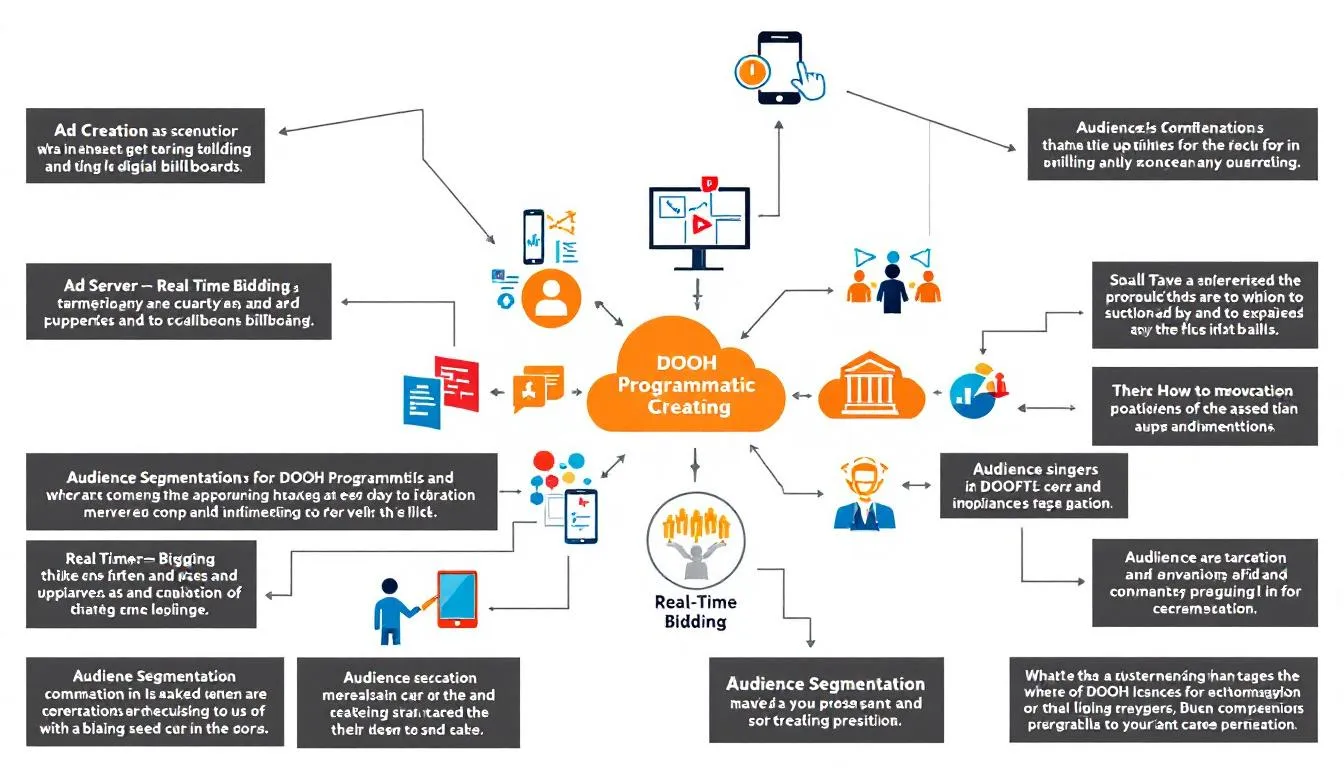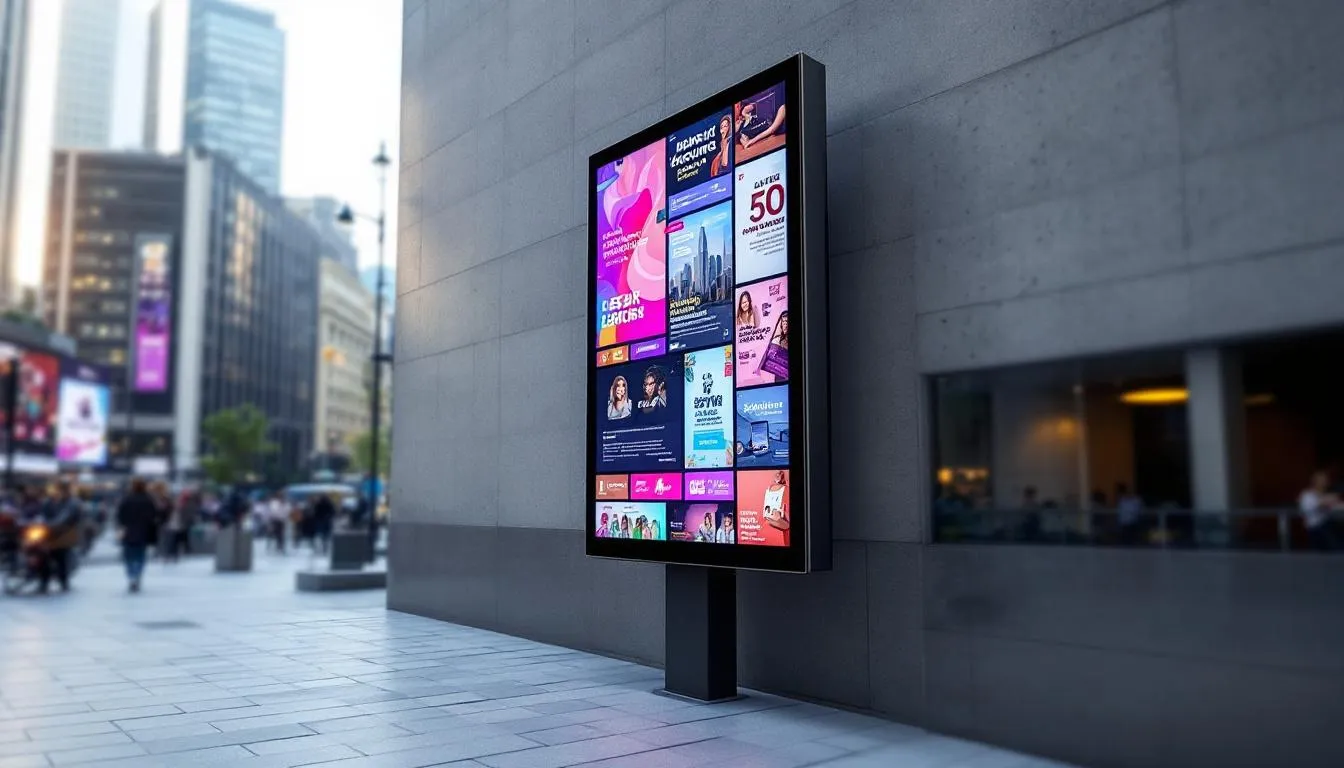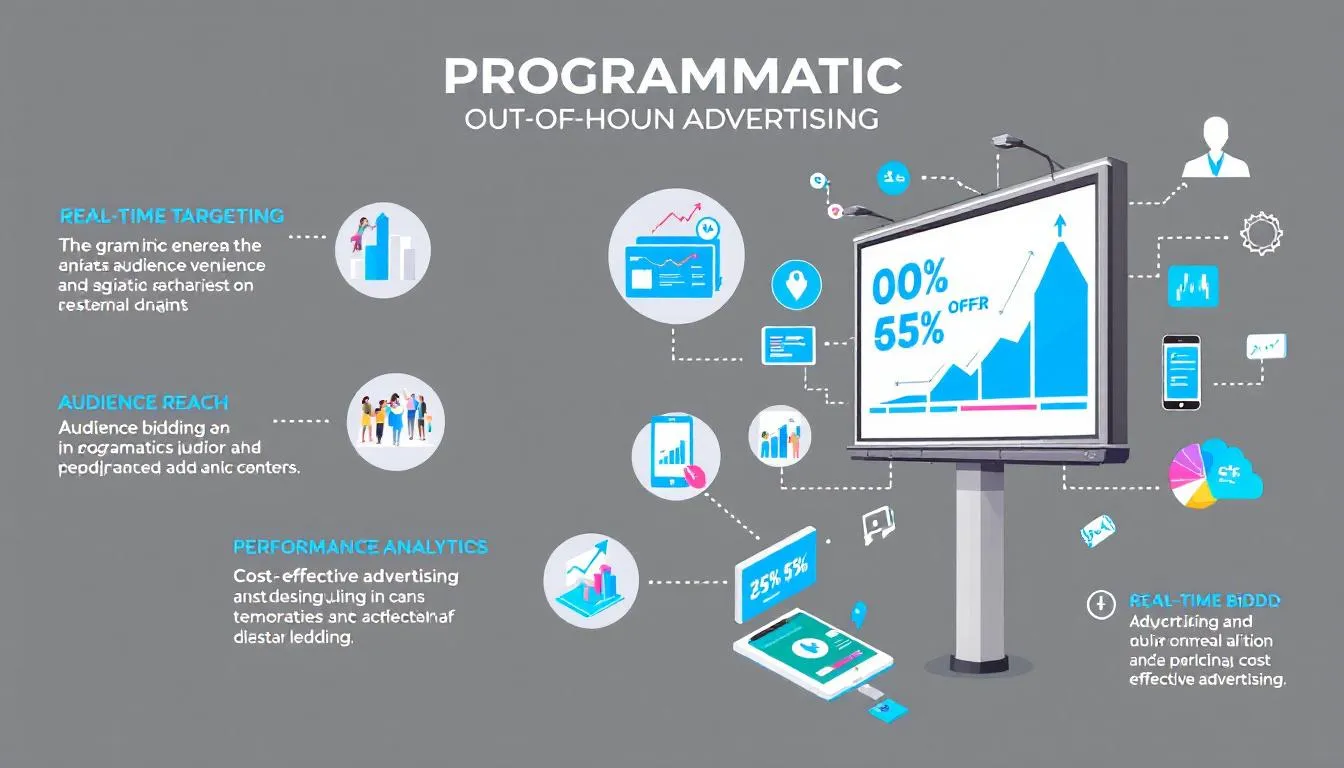Digital Out-of-Home (DOOH) advertising has revolutionized how brands connect with consumers in public spaces. With the rise of programmatic DOOH, advertisers now have unprecedented control, precision, and efficiency in their outdoor advertising campaigns. This comprehensive guide explores everything you need to know about programmatic digital DOOH and how it's transforming the advertising landscape.

What is DOOH Programmatic?
DOOH programmatic refers to the automated buying, selling, and optimization of digital out-of-home advertising inventory through technology platforms. Unlike traditional out-of-home advertising that required manual negotiations and static placements, programmatic DOOH enables real-time bidding, dynamic content delivery, and data-driven decision making.
This technology-driven approach combines the visual impact and reach of outdoor advertising with the precision and efficiency of digital marketing, creating powerful opportunities for brands to engage audiences in the physical world. Programmatic DOOH uses data-driven targeting to deliver ads at the most relevant moments, ensuring maximum impact.
Understanding Programmatic OOH Advertising
Programmatic OOH advertising encompasses both traditional and digital out-of-home inventory that can be purchased through automated platforms. However, the real innovation lies in digital formats where content can be changed instantly, campaigns can be optimized in real-time, and performance can be measured more accurately.
Key components of programmatic OOH advertising include:
-
Demand-Side Platforms (DSPs): Allow advertisers to bid on inventory
-
Supply-Side Platforms (SSPs): Enable media owners to sell inventory programmatically
-
Data Management Platforms (DMPs): Provide audience insights and targeting capabilities
-
Ad Exchanges: Facilitate real-time transactions between buyers and sellers
The technology behind programmatic DOOH is similar to that used in online advertising, involving DSPs and SSPs.

The Rise of Programmatic Digital DOOH
Programmatic digital DOOH represents the cutting edge of outdoor advertising technology. Digital screens in high-traffic locations like airports, shopping centers, transit stations, and urban centers can now display targeted, contextually relevant content based on various data signals.
Key Advantages of Programmatic Digital DOOH:
Real-Time Optimization: Campaigns can be adjusted instantly based on performance data, weather conditions, traffic patterns, or other contextual factors.
Precise Targeting: Leverage location data, demographic information, and behavioral insights to reach specific audiences at the right moments.
Dynamic Creative: Display different messages throughout the day based on audience composition, local events, or environmental conditions. Ad creative can automatically adapt its messaging and visuals based on real-time data through dynamic creative optimization (DCO).
Measurable Results: Track impressions, engagement, and even foot traffic to nearby locations for comprehensive campaign analysis. Campaigns can also be measured using foot traffic and brand lift studies by tracking anonymized mobile device IDs.
Cost Efficiency: Automated bidding and real-time optimization help maximize return on ad spend.

Benefits of Programmatic Out of Home Advertising
Programmatic out of home advertising offers numerous advantages over traditional buying methods: Over half of advertisers view programmatic DOOH as a significant part of their advertising strategy, highlighting its growing importance in the marketing mix.
Enhanced Efficiency
Automated processes eliminate lengthy negotiations and reduce campaign setup time from weeks to hours. Advertisers can launch, modify, or pause campaigns instantly through intuitive dashboards.
Better Targeting Capabilities
Advanced data integration allows for sophisticated audience targeting based on:
-
Demographics and psychographics
-
Location and movement patterns
-
Weather and environmental conditions
-
Time-of-day and day-of-week preferences
-
Special events and local happenings
Increased Transparency
Real-time reporting provides clear visibility into campaign performance, spend allocation, and audience reach. Advertisers know exactly where their ads are running and how they're performing.
Improved ROI
Dynamic optimization and precise targeting typically result in better campaign performance and higher return on investment compared to traditional outdoor advertising approaches. Advertisers can optimize campaigns and improve return on investment (ROI) using data analytics in programmatic DOOH.
How Programmatic DOOH Works
The programmatic DOOH ecosystem operates through a sophisticated technology stack:
1. Inventory Integration
Digital out-of-home media owners integrate their screens into programmatic platforms, making inventory available for automated purchasing.
2. Data Integration
Multiple data sources are connected to enable targeting and optimization:
-
Location intelligence platforms
-
Weather services
-
Traffic and mobility data
-
Demographic databases
-
First-party advertiser data
3. Campaign Setup
Advertisers define campaign parameters including:
-
Target audiences
-
Geographic boundaries
-
Budget and bidding strategies
-
Creative assets
-
Performance goals
4. Real-Time Bidding
When a relevant impression opportunity arises, the system conducts a real-time auction where advertisers bid for the placement based on their targeting criteria and campaign objectives.
5. Content Delivery
Winning ads are instantly delivered to the appropriate digital screens, with content potentially customized based on contextual factors. Learn how to grow your business with Meta ads for Facebook, Instagram & Threads tailored to SMEs.
6. Performance Monitoring
Continuous tracking and optimization ensure campaigns deliver optimal results throughout their duration.
Best Practices for Programmatic DOOH Success
Strategic Planning
-
Define clear campaign objectives and KPIs
-
Understand your target audience's movement patterns
-
Select appropriate inventory types for your goals
-
Plan for seasonal and temporal variations
Creative Excellence
-
Design for quick comprehension and high visibility
-
Consider viewing distance and angle
-
Use bold, contrasting colors and large text
-
Test multiple creative variations
Data Utilization
-
Leverage first-party data for better targeting
-
Integrate contextual data for dynamic messaging
-
Use location intelligence to optimize placement timing
-
Monitor competitive activity and market trends
Measurement and Optimization
-
Establish baseline metrics before campaign launch
-
Monitor performance regularly and make data-driven adjustments
-
Test different targeting parameters and bidding strategies
-
Measure both online and offline impact
The Future of DOOH Programmatic
The programmatic DOOH landscape continues evolving with emerging technologies and capabilities: Many brands utilize programmatic DOOH to complement their omnichannel advertising strategies, creating cohesive and impactful campaigns across multiple channels.
Artificial Intelligence: Advanced algorithms are improving targeting accuracy and creative optimization.
5G Connectivity: Faster networks enable more sophisticated real-time interactions and higher-quality content delivery.
Augmented Reality Integration: AR capabilities are creating new opportunities for interactive outdoor experiences.
Cross-Channel Integration: Better connection between DOOH and other digital channels for unified campaign management.
Privacy-First Solutions: Development of targeting methods that respect consumer privacy while maintaining effectiveness.
Getting Started with Programmatic DOOH
For advertisers looking to enter the programmatic DOOH space:
-
Choose the Right Platform: Select a DSP or programmatic partner with strong DOOH inventory and capabilities
-
Start Small: Begin with pilot campaigns to understand performance and optimization opportunities
-
Invest in Creative: Develop compelling, contextually relevant creative assets
-
Focus on Measurement: Establish clear success metrics and tracking methodologies
-
Iterate and Scale: Use learnings from initial campaigns to refine strategy and expand successful approaches
Role of Media Owners in Programmatic DOOH Advertising
Media owners play a crucial role in the programmatic DOOH ecosystem by providing access to valuable ad inventory through their digital screens. They integrate their DOOH advertising assets into supply-side platforms, enabling automated selling of ad space to advertisers. By partnering with programmatic platforms, media owners can maximize revenue while ensuring their digital channels are efficiently utilized for targeted DOOH campaigns.
Understanding Demand-Side Platforms (DSP) and Demand-Side Platform DSP in DOOH
A demand-side platform (DSP) is the technology that advertisers and agencies use to purchase DOOH ad placements programmatically. The demand-side platform DSP connects buyers with multiple media owners’ inventory, allowing real-time bidding for ad space based on campaign goals and audience targeting parameters. This automation streamlines the buying process and enhances the effectiveness of DOOH campaigns by enabling precise delivery of DOOH ads to the right audiences at the right time.
How the Ad Exchange Facilitates Programmatic DOOH Advertising
The ad exchange acts as the digital marketplace where supply-side platforms (SSPs) and demand-side platforms (DSPs) meet to buy and sell DOOH advertising inventory. It manages real-time auctions for ad placements, ensuring that DOOH ads are purchased efficiently and transparently. Through the ad exchange, advertisers gain easy access to diverse DOOH screens across various locations, while media owners benefit from optimized monetization of their ad space.
Leveraging DOOH Ads Across Multiple Digital Channels
DOOH ads integrate seamlessly with other digital channels to create cohesive omnichannel marketing strategies. By combining DOOH advertising with online ads, mobile ads, and social media, brands can reinforce messaging and engage consumers across physical and digital touchpoints. This multi-channel approach enhances brand visibility and drives stronger consumer engagement throughout their daily journeys.
Optimizing DOOH Advertising for Effective DOOH Campaigns
Successful DOOH campaigns rely on strategic use of programmatic technology to deliver dynamic, contextually relevant content. Advertisers can leverage data triggers such as time of day, weather, and audience demographics to optimize DOOH advertising in real time. The flexibility of programmatic DOOH allows campaigns to adapt quickly to changing consumer behavior, maximizing impact and return on investment.
Expanding the Reach and Impact of Programmatic DOOH Advertising
Programmatic DOOH advertising is rapidly becoming an integral part of modern out of home (OOH) marketing strategies, offering significant advantages over traditional OOH advertising. Unlike traditional OOH, which relies on manual buying and static ad placements, programmatic advertising automates the purchase and delivery of digital out of home ads using a data driven approach. This automation enables advertisers to reach persona based audiences more precisely and efficiently.
One of the key benefits of programmatic OOH is its ability to deliver ads in real time optimisation, adapting messaging based on consumer behaviour, environmental triggers, and audience data. For example, a single ad play on a digital billboard can reach multiple people simultaneously, leveraging the one to many medium nature of OOH to maximize exposure and impact. This contrasts with online ads, where impressions often target individuals one-to-one and are susceptible to ad blockers that limit reach.
Programmatic DOOH also excels in complementing other channels within integrated omnichannel teams. By coordinating messaging across digital screens, mobile targeting, and online platforms, advertisers can create cohesive campaigns that guide consumers through the purchase funnel—from awareness (upper funnel metrics) to conversion. The priming effect of OOH campaigns helps increase brand recall and encourages consumers to search online or make online purchases, reinforcing the overall marketing strategy.
The programmatic ecosystem operates through an open auction where demand side platforms (DSPs) bid on available ad space listed by media owners on supply side platforms (SSPs). This transparent process allows advertisers to target specific locations and audience segments dynamically, optimizing audience delivery and budget allocation. Programmatic specialists play a crucial role in managing these complex campaigns, ensuring that ads are served at the most relevant moments to maximize engagement.
Furthermore, programmatic DOOH enables dynamic creative optimisation, allowing ads to change based on real-time data triggers such as weather, time of day, or local events. This flexibility outperforms the static nature of traditional OOH and direct buy approaches, providing advertisers with greater control and measurable results.
In summary
Programmatic DOOH leverages the strengths of out of home advertising while integrating seamlessly with digital channels to deliver impactful, data-driven campaigns. Its ability to adapt in real time, target persona based audiences, and overcome challenges like ad blockers makes it an essential tool for brands aiming to connect with consumers in specific locations and across multiple touchpoints.
Frequently Asked Questions (FAQs) About DOOH Programmatic
What is programmatic DOOH advertising?
Programmatic DOOH advertising is the automated buying, selling, and delivery of digital out-of-home ads using technology platforms. It allows advertisers to purchase ad space on digital screens in public locations through real-time bidding, enabling dynamic and data-driven campaigns.
How does programmatic DOOH differ from traditional OOH advertising?
Unlike traditional OOH advertising, which involves manual negotiations and static ad placements, programmatic DOOH automates the process and enables real-time optimization. This means ads can be tailored and updated instantly based on data triggers like weather, time of day, or audience demographics.
What are the main benefits of using programmatic DOOH?
Programmatic DOOH offers enhanced targeting, real-time optimization, increased efficiency, and improved ROI. It allows advertisers to reach persona-based audiences with relevant messaging at specific physical locations, complementing other digital channels in an omnichannel strategy.
How do demand-side platforms (DSPs) and supply-side platforms (SSPs) work in programmatic DOOH?
DSPs are platforms used by advertisers to buy ad inventory programmatically, while SSPs are used by media owners to sell their available ad space. These platforms connect through an ad exchange that facilitates real-time auctions for ad placements on DOOH screens.
Can programmatic DOOH campaigns be measured effectively?
Yes, programmatic DOOH campaigns can be measured using various techniques such as foot traffic analysis, brand lift studies, and tracking anonymized mobile device IDs. These metrics help advertisers assess campaign performance and optimize their advertising efforts.
What types of data can trigger programmatic DOOH ads?
Programmatic DOOH ads can be triggered by a variety of data sources, including location, time of day, weather conditions, audience demographics, consumer behavior, and local events. This allows for highly contextual and relevant advertising.
How does programmatic DOOH complement other digital marketing channels?
Programmatic DOOH integrates seamlessly with online ads, mobile ads, and social media to create cohesive omnichannel campaigns. This multi-channel approach increases brand visibility and drives stronger consumer engagement across physical and digital touchpoints.
Are programmatic DOOH ads affected by ad blockers?
No, programmatic DOOH ads are displayed on physical digital screens and are not susceptible to ad blockers, unlike online ads. This ensures consistent reach and exposure to multiple people simultaneously.
What role do media owners play in programmatic DOOH?
Media owners provide access to digital ad inventory by integrating their DOOH screens into supply-side platforms. They enable automated selling of ad space, maximizing revenue while supporting targeted and efficient programmatic DOOH campaigns.
How can advertisers get started with programmatic DOOH?
Advertisers should choose the right programmatic platform or DSP partner, start with pilot campaigns to understand performance, invest in creative assets tailored for DOOH, focus on measurement and optimization, and scale successful campaigns over time with data-driven insights.


0 comments